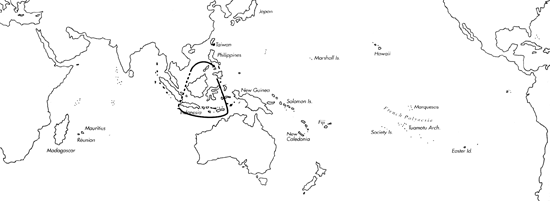Range: Palawan and Sulu Archipelago (Philippines) to N. Timor Sea and Java (E. Indonesia).
Description: Moderately small to moderately large, moderately solid to solid; specimens described as C. bitleri (Pl. 36, Fig. 17) somewhat smaller and more solid than typical shells. Last whorl conical to conoid-cylindrical, broader and conical to ventricosely conical in specimens described as C. bitleri; outline convex at adapical fourth, less so or straight below. Shoulder angulate. Spire low, outline concave; apex may project from an otherwise flat spire. Larval shell of about 2 whorls; maximum diameter about 0.6-0.7 mm. First 4-6 postnuclear whorls weakly tuberculate. Teleoconch sutural ramps flat, slightly concave in late whorls, with prominent axial threads; 4-6 major spiral grooves on later ramps, sometimes weaker and often containing spiral threads in latest whorls. Last whorl with variably wide spiral grooves on basal third or somewhat beyond, separating ribs and ribbons.
| Shell Morphometry | ||
|---|---|---|
| L | 35-72 mm | |
| (-form bitleri 30-43 mm) | ||
| RW | 0.13-0.42 g/mm | |
| (L 35-60 mm; -form bitleri 0.22-0.32 g/mm; (L 30-36 mm)) | ||
| RD | 0.50-0.58 | |
| (-form bitleri 0.59-0.68) | ||
| PMD | 0.82-0.90 | |
| RSH | 0.01-0.11 | |
| (-form bitleri 0.05-0.13) | ||
Last whorl with a light yellowish brown to brown network of coarse lines and blotches, edgmg rather large white tents and flecks sometimes with darker outlining toward outer lip. Pattern often concentrates into adapical and abapical brown spiral bands. Shells with regularly reticulate pattern intergrade with shells with prominent spiral colour bands and with shells with a reduced network and large, often confluent white markings (described as C. bitleri; Pl. 36, Fig.17). Apex white. Later sutural ramps with radial lines, streaks or blotches coalescing with last whorl pattern and of the same colour. Aperture white.
Habitat and Habits: Intertidal to 20 m; on sand or mud.
Discussion: C. cordigera closely resembles C. nobilis. The latter species differs mainly in its non-tuberculate early and carinate later postnuclear whorls, and its coarse alternating brown and white spiral lines within the larger solid brown areas of its last whorl. For comparison with C. marchionatus, see the Discussion of that species. Whether specimens from the Sulu Archipelago, described as C. bitleri, represent a form of sympatric C. cordigera or a separate species, can only be decided on the basis of reliable data on their anatomy. In Balabac, Palawan, typical specimens of C. cordigera intergrade with specimens of C. bitleri.

C. cordigera range map
This section contains verbatim reproductions of the accounts of 316 species of Conus from the Indo-Pacific region, from Manual of the Living Conidae, by Röckel, Korn and Kohn (1995). They are reproduced with the kind permission of the present publisher, Conchbooks.
All plates and figures referred to in the text are also in Röckel, Korn & Kohn, 1995. Manual of the Living Conidae Vol. 1: Indo-Pacific Region.
The range maps have been modified so that each species account has it own map, rather than one map that showed the ranges of several species in the original work. This was necessary because each species account is on a separate page on the website and not confined to the order of accounts in the book.